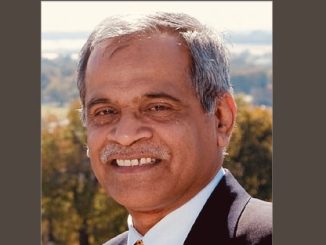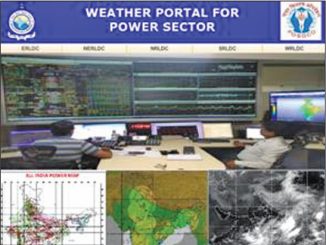 Power System Operation Corporation Limited (POSOCO), which has been efficiently managing the electric grid, plans to continue focusing on grid security, reliability and resilience, especially in view of the growing integration of renewables, an ageing transmission network and the expected increase in power demand, notes K.V.S. Baba, CMD, POSOCO. In an interview with Power Line, he, shares his views on the evolution of the grid, the changes and challenges expected in the next few decades, and some solutions…
Power System Operation Corporation Limited (POSOCO), which has been efficiently managing the electric grid, plans to continue focusing on grid security, reliability and resilience, especially in view of the growing integration of renewables, an ageing transmission network and the expected increase in power demand, notes K.V.S. Baba, CMD, POSOCO. In an interview with Power Line, he, shares his views on the evolution of the grid, the changes and challenges expected in the next few decades, and some solutions…
What, in your view, have been the most noteworthy achievements in the power sector over the past 25 years?
Over the past 25 years, the power sector has been one of the most critical components of infrastructure development and is crucial for sustained economic growth and welfare of the country. The Government of India’s thrust on “Power for All” accelerated the augmentation of generation and transmission capacity in the country to reduce energy and peak shortage.
The Electricity Act, 2003 brought about a paradigm shift by delicensing generation and mandating non-discriminatory open access. The regulatory frameworks facilitated the evolution of the organised market for electricity in India and paved the way for the introduction of reserve regulation ancillary services, security constrained economic despatch and automatic generation control in the Indian power system.
The interconnection of regional grids to form a synchronous national grid has helped in harnessing diversity, enabled optimisation of resources, enhanced resilience and facilitated growth in renewable energy in the country and expansion of the electricity market. Various amendments to the Indian Electricity Grid Code, transmission planning criteria and sharing regulations have brought about positive and far-reaching changes in transmission planning and grid operation to enhance grid security and reliability.
The institution of system operation has been strengthened and further empowered. Transnational interconnections with neighbouring countries have enhanced regional cooperation and energy security.
The introduction of the renewable energy certificates (RECs) and the energy saving certificate (ESCert) mechanisms has enhanced participation of stakeholders in the energy transition.
How have grid operations evolved in the past 25 years? What are the areas where the grid still needs improvements?
The increase in the system size over the years, interconnection of regional grids within India as well as cross-border interconnections to form a very large synchronous grid, evolving consumer load profiles, changing network characteristics due to the increased deployment of flexible AC transmission systems (FACTS)/high voltage direct current (HVDC) elements, rapid growth in renewable energy in the grid, along with a thrust on sectoral coupling through electrification and the occurrence of extreme natural events has increased challenges in grid operations manyfold. The challenges are being met by improving stakeholder coordination, system visualisation, data analytics, system simulation studies, system automation, flexibility, resilience, deployment of optimisation techniques and operator training.
Grid operation would benefit by strict compliance with technical standards by all grid users, improving demand/renewable energy forecasting, resource adequacy, maintaining flexible reserves, strengthening of wideband communications, implementation of SAMAST (scheduling, accounting, metering and settlement of transactions in electricity) and CABIL (capacity building of Indian load despatch centres) framework, strengthening of intra-state transmission and distribution network and empowering of state load despatch centres.
“The integration of new actors such as EVs, storage, green hydrogen and DSOs will be a key focus area.”
What will be the biggest challenge in power system operation and maintaining of grid reliability over the next 25 years?
Over the next 25 years, the electrical grid will experience many challenges, including a changing composition of generation resources with an increase in renewable and distributed generation, an ageing AC transmission infrastructure and increase in electricity demand. These challenges are already stressing the existing infrastructure and resulting in operation closer to grid stability limits. The future of the power system would have more integration of energy sources for a cleaner environment. The application of HVDC and FACTS would provide performance solutions for network control. It would also include applications of electric vehicles (EVs). The institution of distribution system operators for the management of distributed demand-side resources with bidirectional flows and a large quantum of generation behind-the-meter would pose major challenges to the system operation.
Operational challenges include fast ramping, variability, intermittency, potential grid instabilities resulting from loss of inertia, loss of visibility and controllability of behind-the-meter resources, load stagnation/oversupply, inadequate communication interfaces and operator training. Flexible operation of the existing conventional generation is being increasingly called for. The deepening of the markets through the introduction of new products and the increase in the number of players would affect the scale and complexity of grid operation.
The challenge of market transformation to harness flexibility needs to be addressed. Market-based procurement of ancillary services, especially from renewable resources, would be needed. Introduction of fast markets in terms of 5-minute scheduling and settlement systems has already been tested in pilot mode and hence would need an appropriate regulatory framework. New market instruments for adequacy, balancing and demand res-ponse, along with financial instruments to hedge against risks would need greater coordination for physical and financial markets. Cross-border players’ participation in the Indian electricity market is already a rising trend and hence suitable measures would be needed for regional market cooperation.
“The deepening of the markets through the introduction of new products and the increase in the number of players will affect the scale and complexity of grid operation.”
What have been POSOCO’s biggest achievements in the past few years?
The introduction of frequency control through reserves and ancillary services has been one of the key achievements towards operational security and reliability. There has been emphasis on flexibility in operations in terms of generation, transmission, distribution and markets’ side.
The introduction of SCED has enabled an optimisation-based paradigm for system operations. The refinement in imbalance pricing with market linkages has been key to imbalance management. The introduction of closer to real-time electricity markets has supported portfolio management of utilities with lesser leaning on the grid. Integrated web-based energy scheduling pan-India and gate closure have enabled fast data transfer and visibility for operations on a 15-minute time-block basis.
There is state-of-the-art on a supervisory control and data acquisition/EMS energy management system in control rooms and situational awareness on renewables through pan-India renewable energy management centres. Synchrophasor technology deployment and application have given deep insights into post-despatch analysis, ensuring grid resilience. Data, controls and automation have enabled big data analytics and visualisations for better systems operations. Sustainability through RECs and ESCerts is being promoted towards decarbonisation of the Indian economy.
What will be POSOCO’s focus areas in the coming years?
In the coming years, POSOCO would continue its focus on system security, reliability, resilience through resource adequacy, network modelling and simulation studies, forecasting, assessment and deployment of reserves and optimisation. We would work towards enhancing transparency, stakeholder coordination and collaboration with academia. Our internal policies would focus on talent management, empowering our HR and keeping them motivated to meet growing stakeholder expectations.
The integration of new actors such as EVs, storage, green hydrogen and distribution service operators would be a key focus area. Seams management with nested/fragmented control areas would attain significant importance. Energy and capacity procurement with physical and financial market structures in various time horizons would be needed to ensure resource adequacy. Inertia monitoring and assessment would be essential with increasing penetration of renewables. The challenge of integrating geographically concentrated large-scale renewables has to be factored in for grid security and reliability. Harnessing essential reliability services from renewables and customer-owned resources, along with voltage control and black-start ancillary services, would be key to provide grid balancing services in a fast and cost-effective manner.
 Risk-based probabilistic transmission planning processes and criteria, along with non-wires alternatives, have to be considered. Offshore wind and hybrid renewables (wind-solar, wind-solar-storage, etc.) would also be part of the generation mix. Digital infrastructure, cybersecurity and ways of work scalable with interoperable information and communication systems have to be emphasised in the “new normal”. Modernisation of control centres with artificial intelligence tools and maximisation of system performance are some of the key areas that can ensure efficient system operations. The expansion of the regional footprint with multilateral cross-border trade would lead to regional electricity transactions for energy security and cooperation.
Risk-based probabilistic transmission planning processes and criteria, along with non-wires alternatives, have to be considered. Offshore wind and hybrid renewables (wind-solar, wind-solar-storage, etc.) would also be part of the generation mix. Digital infrastructure, cybersecurity and ways of work scalable with interoperable information and communication systems have to be emphasised in the “new normal”. Modernisation of control centres with artificial intelligence tools and maximisation of system performance are some of the key areas that can ensure efficient system operations. The expansion of the regional footprint with multilateral cross-border trade would lead to regional electricity transactions for energy security and cooperation.
What is your outlook for the power sector in the next 25 years?
There is a positive outlook for the power sector in the next 25 years. India is on track to achieve the set renewable energy target of 450 GW by 2030. Consumer-centricity would be key to meet needs with active participation of prosumers. The markets have to cater to the diverse needs of grid security, reliability and economy. There would be increasing focus on the aggregation of distributed resources, for example, solar rooftops and participation in the markets. The sectoral coupling with electrification of transportation would be a major driver for demand growth and flexibility resources. The new forms of energy storage such as low-impact pumped storage plants and batteries would support balancing of the grid with reliability support services. The adaptation of green hydrogen technology for various sectors of the Indian economy would be significant in the clean energy transition. There would be significant measures to make the grid “storm-hardy” and electricity infrastructure resilient to various risks posed by climate change and other phenomena.



